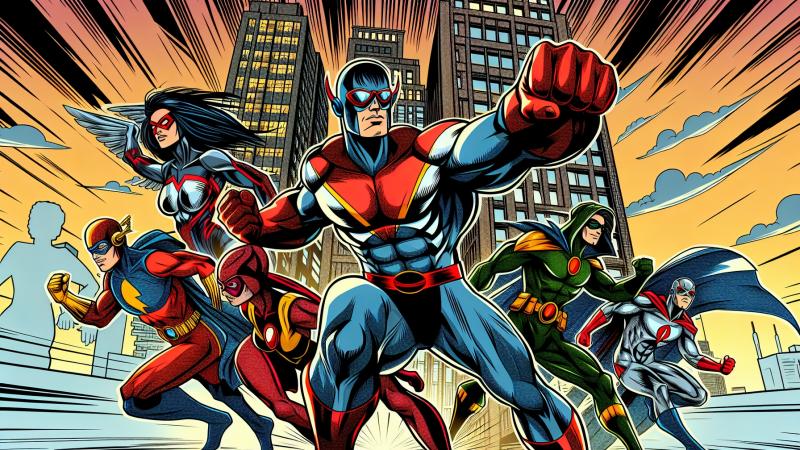
Welcome back to Comic Book Club! In this episode of the show, we discussed the backstory of Blue Beetle, a classic superhero who first appeared in 1939. This tale is a bit longer than our previous reads, but I think you'll enjoy it. You can grab your own free copy in the Marketplace and
read along here.
Background of Blue Beetle
While DC Comics now owns Blue Beetle, the character was originally created by Fox Features Syndicate. By 1939, the massive success of Superman and Batman inspired many similar superheroes. The idea that previously unknown heroes could suddenly sell hundreds of thousands of copies was too tempting to resist, leading to a flood of costumed characters from publishers large and small.
Victor Fox, an accountant for DC, saw the sales figures and promptly opened his own office just a few floors away. He hired Will Eisner to write and draw a deliberate imitation of Superman called Wonder Man for Wonder Comics (May 1939). After DC sued Fox, he canceled Wonder Man but didn't give up. Later in 1939, he found some success with the Blue Beetle.
The series featured Dan Garrett, the original Golden Age Blue Beetle, and lasted fifty-nine issues. Garrett first appeared as the Blue Beetle in Mystery Men Comics #1 in August 1939.
The Three Incarnations of Blue Beetle
Dan Garrett
The original Blue Beetle was a police officer who wore a bulletproof suit and took a strength-enhancing drug called "Vitamin 2X" to gain superpowers.
Ted Kord
In 1966, Charlton Comics introduced Ted Kord, Dan Garrett's student, who continued the Blue Beetle legacy without superpowers. Instead, he used his wits, humor, gadgets, and fists to fight crime.
Jaime Reyes
In 2006, DC introduced Jaime Reyes as the third Blue Beetle. Revealed to be of alien origin, the scarab bonds with Reyes and provides him with a suit of extraterrestrial armor shortly after Kord's death.
The Original Blue Beetle Comic
Did you like the story more or less compared to our other readings? Share your thoughts in the comments.
The story reflects the Golden Age of comics with its straightforward crime-fighting themes. The evolution of Blue Beetle through the decades is fascinating.
Why did superheroes became so popular in the 1940s?
The Great Depression, rise in Mob activity, and the World Wars made people seek a way to escape. This need for heroes is why so many early superheroes are patriotic (Captain America, GI Joe) or government officials turned vigilantes, like Blue Beetle and The Spirit. Even the wealthy-turned-vigilante, like Batman or Ironman, depict the value society had in finding heroes in everyday people.
Comparing Superhero Origin Stories
How does Dan Garrett's origin story compare to others?
Major superheroes often have origin stories filled with loss, transformation, and a quest for justice, but each one is unique. Batman's story begins with the murder of his parents, which drives him to become a vigilante and protect Gotham City. Superman, an alien from Krypton, was sent to Earth as a baby. Growing up, he searches for his identity and becomes a symbol of hope and justice. Spider-Man's journey is marked by the death of his uncle, teaching him that "with great power comes great responsibility." Wonder Woman, created from clay and brought to life by Greek gods, is driven by a mission of peace and equality. Despite their different backgrounds, each hero turns personal tragedy into a motivation to fight for the greater good, showing how ordinary people can become extraordinary heroes.
Superhero stories share these themes of loss and a quest for justice. Dan Garrett, as a police officer whose father was murdered by a criminal, fits into the mold of ordinary individuals taking on extraordinary roles.
Evolution of Blue Beetle
How has the character evolved from Dan Garrett in the 1940s to Jaime Reyes in today's DC Comics?
Dan Garrett, a traditional Golden Age hero, was a police officer with powers derived from taking vitamins and the mythical power of the blue beetle.
Ted Kord, his 1960s successor, had no superpowers and relied on his intellect and gadgets, bringing a light-hearted, tech-savvy approach.
In 2006, Jaime Reyes revitalized the Blue Beetle as a relatable teenager with an alien-based exoskeleton, blending action with themes of cultural identity and personal growth. The hero changes as cultural norms and society evolve.
Timeless and Enduring Heroes
Do you think Blue Beetle deserves to be considered a "timeless and enduring hero" like Superman and Batman?
The Blue Beetle has the potential to be timeless. Each incarnation has brought something unique to the character, reflecting the times and keeping the hero relevant. While not as well known as other DC heroes, the Blue Beetle has managed to keep its story alive. In fact, DC released the
Blue Beetle movie in 2023 featuring the latest iteration of the hero, Jaime Reyes
